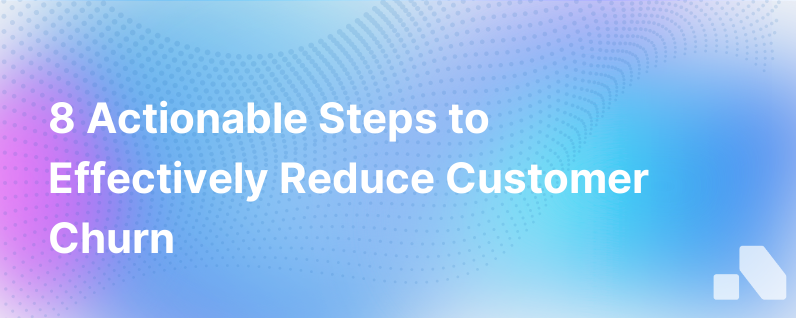Step By Step Guide 8 Ways To Mitigate Churn And Come Out On Top
Published on December 16, 2023 by Sawyer Middeleer
Churn, the dreaded metric that keeps B2B leaders awake at night, is often seen as an inevitable part of doing business. It's not just a measure of lost revenue; it reflects on lost opportunities and potential damage to your brand's reputation. However, churn can be mitigated and managed effectively. In this comprehensive guide, we'll walk through eight strategic steps that will not only help you reduce churn but also position your company on a trajectory towards growth and customer loyalty.
1. Understand the ‘Why’ Behind Churn
Understanding why customers are leaving is the first step in mitigation. Initiate exit interviews and surveys with churned customers to pinpoint specific reasons. Is it a product issue, customer service dissatisfaction, or something else entirely? Dive into your churn data analytics to spot patterns and trends.
Action Steps:
- Create an exit survey for churned customers.
- Review customer support tickets, feedback, and complaints for common threads.
- Analyze churn data for patterns regarding time, product usage, and customer segments.
2. Prioritize Customer Success from Day One
Customer success is not just a reactive measure but a proactive strategy to anticipate customer issues and provide solutions before a customer even considers leaving. Ensure your onboarding process sets up the customer for success, offering adequate training and resources.
Action Steps:
- Develop a comprehensive onboarding plan that addresses common pain points.
- Assign dedicated customer success managers to high-value accounts.
- Implement customer education programs to encourage effective product usage.
3. Enhance Product Value
Your product must evolve along with your customers' needs. Collect and act on feedback to ensure your services remain valuable and indispensable. Implement a system to regularly update your offerings and innovate based on customer input.
Action Steps:
- Create feedback loops with customers through surveys, forums, and advisory boards.
- Use customer feedback to guide product development and feature updates.
- Clearly communicate product updates to customers, emphasizing the added value.
4. Foster Strong Relationships
In B2B markets, relationships are currency. Strong customer relationships can weather storms that would otherwise lead to churn. Regular check-ins, personalized communication, and a partnership approach to your customer relationships can make all the difference.
Action Steps:
- Schedule regular business reviews with customers to understand their goals and challenges.
- Personalize communication to reflect customers’ industry, use case, and corporate culture.
- Use CRM tools to track relationship touchpoints and customer health.
5. Identify At-Risk Customers Early On
By tracking customer engagement and product usage, you can identify and address at-risk accounts before they churn. Set up alerts for decreased usage or poor health scores, and have intervention plans ready to re-engage these customers.
Action Steps:
- Implement a customer health score system based on product usage, engagement metrics, and support interactions.
- Monitor these metrics closely and create outreach plans for customers showing red flags.
- Conduct regular health checks and have an intervention protocol in place to re-engage and retain.
6. Deliver Exceptional Customer Service
Exceptional customer service can not only solve problems but also transform a potentially negative experience into a positive one. Ensure your customer service is responsive, empathetic, and effective. When issues are resolved swiftly and beyond expectations, customer loyalty can be strengthened.
Action Steps:
- Train support staff in conflict resolution and empower them to make customer-centric decisions.
- Implement customer service best practices and benchmarks for response and resolution times.
- Solicit feedback on customer service interactions to continuously improve.
7. Offer Tailored Solutions and Customization
Nothing beats feeling like a product or service was made just for you. If your platform allows for customizations or tailored solutions, promote these options to your customers. Helping them make your product feel like their own can deepen the customer's investment in your service.
Action Steps:
- Engage customers in discussions about their ideal outcomes and work towards tailored solutions.
- Promote customization and personalization features of your product.
- Create case studies or testimonials showcasing successful custom implementations.
8. Incentivize Loyalty and Advocate for Referrals
Leveraging loyalty programs and referral incentives can enhance customer retention and bring in new business. Provide perks or benefits to long-term customers and encourage them to share their positive experiences with others.
Action Steps:
- Develop a loyalty program with rewards that matter to your B2B customer base.
- Create a referral incentive program that rewards customers for bringing in new business.
- Celebrate customer milestones and successes publicly when possible (with their permission).
Conclusion
Mitigating churn requires a multi-faceted approach tailored to your unique business and customer base. By understanding why churn occurs, investing in customer success, maintaining a strong relationship with customers, and delivering a level of service that exceeds expectations, B2B companies can effectively reduce churn rates and emerge stronger.
Finally, by consistently reviewing and evolving these strategies, a company can adapt to changing market dynamics and customer expectations, staying one step ahead of churn. Remember, every customer retained is a testament to your business's value and your team's dedication to excellence.